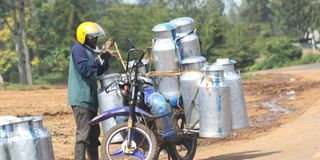Deliveries of milk fall as Covid-19 bites hard

A man ties empty milk cans to his motorcycle at Mwiciune in Imenti South, Meru County on November 18, 2017. Due to Covid-19 impact, dairy farmers now prefer to sell their milk to hawkers for quick payments.
What you need to know:
- Covid-19, reported in Kenya mid-March, continues to adversely affect the sub-sector with June registering 40.25 million litres, the lowest since March 2017.
- According to the Kenya Dairy Board, logistic challenges also hurt milk deliveries with transporters now shunning night-long collection in adherence to the 9pm to 4am curfew.
- Dairy farmers have resorted to selling at farm-gates to motorcycle hawkers who go around estates looking for consumers.
Milk deliveries dropped by 8.24 million litres in the first half of 2020 compared to a similar period last year when processors received 319.1 million litres.
While the first three months registered a commendable performance 173.36 million litres, the second quarter witnessed a 20.7 percent or 35.9 million litres less delivered with 137 million litres reaching factories.
Covid-19, reported in Kenya mid-March, continued to adversely affect the sub-sector with June registering 40.25 million litres, being the lowest since March 2017 when 38.64 million litres were delivered.
The trend reveals falling levels of disposable incomes among dairy farmers who now prefer on-the-spot cash payments by selling to hawkers as opposed to waiting for monthly earnings from processors.
According to the Kenya Dairy Board, logistic challenges also hurt milk deliveries with transporters now shunning night-long collection in adherence to the 9pm to 4am curfew.
Dairy farmers have protested against Covid-19 rules that outlaw movement saying it has disrupted milk transporters who no longer ply their routes in the wee hours of the morning.
Many have resorted to selling at farm-gates to motorcycle hawkers who go around estates looking for consumers.





